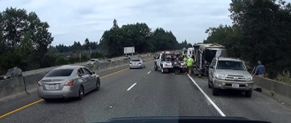Lesson Six: Emergency Vehicles (6.6)
Fire trucks, police, and ambulances present their own risks. When these vehicles are responding to emergencies, they move quickly and may make maneuvers (such as changing lanes) with little warning to other drivers.

Yielding for an Emergency Vehicle
Emergency vehicles are all equipped with emergency lights and sirens. Oregon law requires drivers to pull as far as possible to the right and stop when they see an emergency vehicle approaching with its lights flashing or sirens activated. They can proceed only after the emergency vehicle has passed.
 Emergency Vehicles
Emergency Vehicles
Move Over Law
Drivers must move over to a non-adjacent lane (or slow down) when approaching the rear of police, fire, and ambulance vehicles, as well as any motor vehicle that is stopped and is displaying required warning lights or hazard lights, or a person is indicating distress by using emergency flares or posting emergency signs.
Most importantly, drivers should be alert. If you can safely move over when approaching a vehicle stopped for an emergency, do so. If you can’t, slow down and change lane positions away from the emergency situation.
Slow down means reducing your speed by at least five miles per hour below the posted speed of the roadway.
 Move Over
Move Over
Essential Question
-
How do you interact lawfully, safely, and courteously with emergency vehicles?